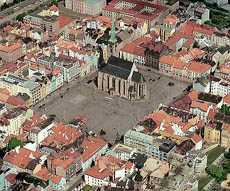
A part of the new Italian pavement in the square in Pilsen needs to be redone
 |
According to architect Jan Soukup, a parking lot should not have been permitted there and they should have waited through the winter for the pavement to settle. "The investment department and the investor came up with six variants on how to make the pavement durable," stated Deputy Mayor Jiří Uhlík. Samples are to be tested in the still unpaved part of the square in ten days. The use of deeper stones is also being considered. The most frequently overturned slabs are six centimeters thick.
The director of the investment department, Evžen Kaucký, said that the pavement would be improved by grouting. Stones in small grids will be laid on special materials. "Or we will use blocks that are 16 centimeters high, laid into gravel or concrete with special grouting material," he noted. Concerns about the poor quality of the stone are said to be unnecessary.
A part of the completed pavement was laid by Kamenoprůmysl Plzeň, which belongs to Jaroslav Holler, the brother of Deputy Mayor Marcela Krejsová. Holler sees the main problem as being the fact that heavy vehicles drove over the freshly laid pavement. However, he admits that it was improperly laid in some places. "In the parking lot, it is poorly done. Areas need to be dug up, underpinned, and repaired," he said.
According to heritage conservationist Petr Domanický, the problems are a consequence of the city's refusal to use traditional massive granite pavement from Štěnovice near Plzeň. He views the effort to improve the method of laying the new pavement pessimistically, as it is reportedly difficult to estimate the condition after ten years.
The English translation is powered by AI tool. Switch to Czech to view the original text source.
2 comments
add comment
Subject
Author
Date
Světlý bod v Ústecké architektonické marnosti
Pietro
19.03.10 10:33
To Petro:
Thomas
20.03.10 12:12
show all comments






